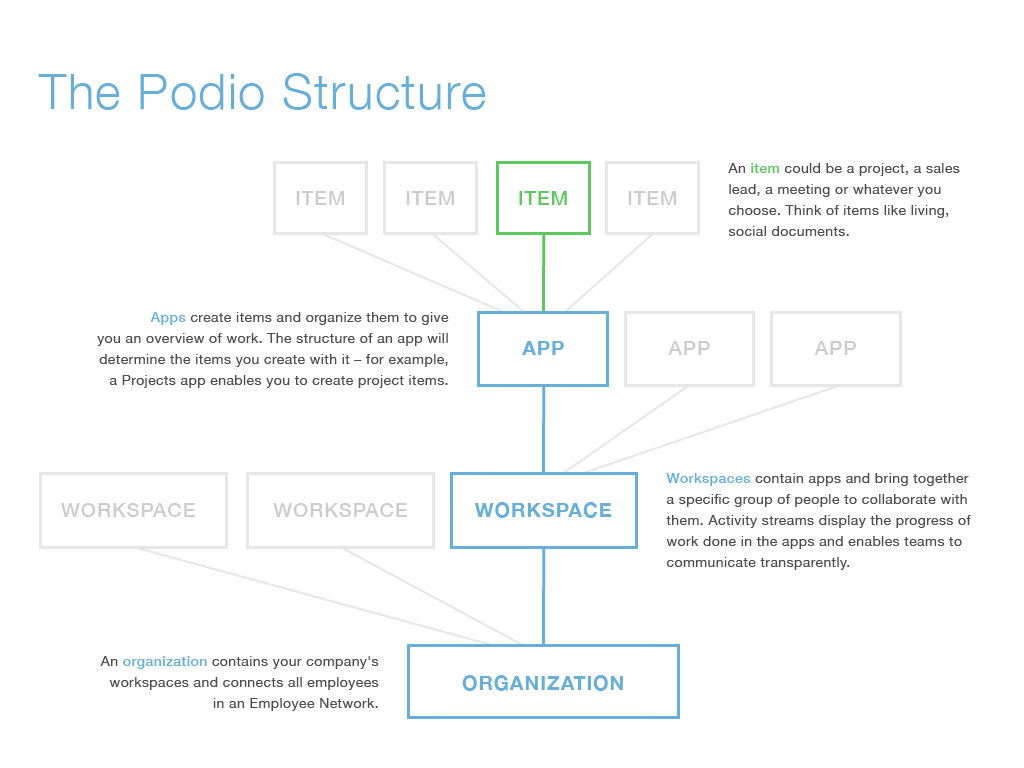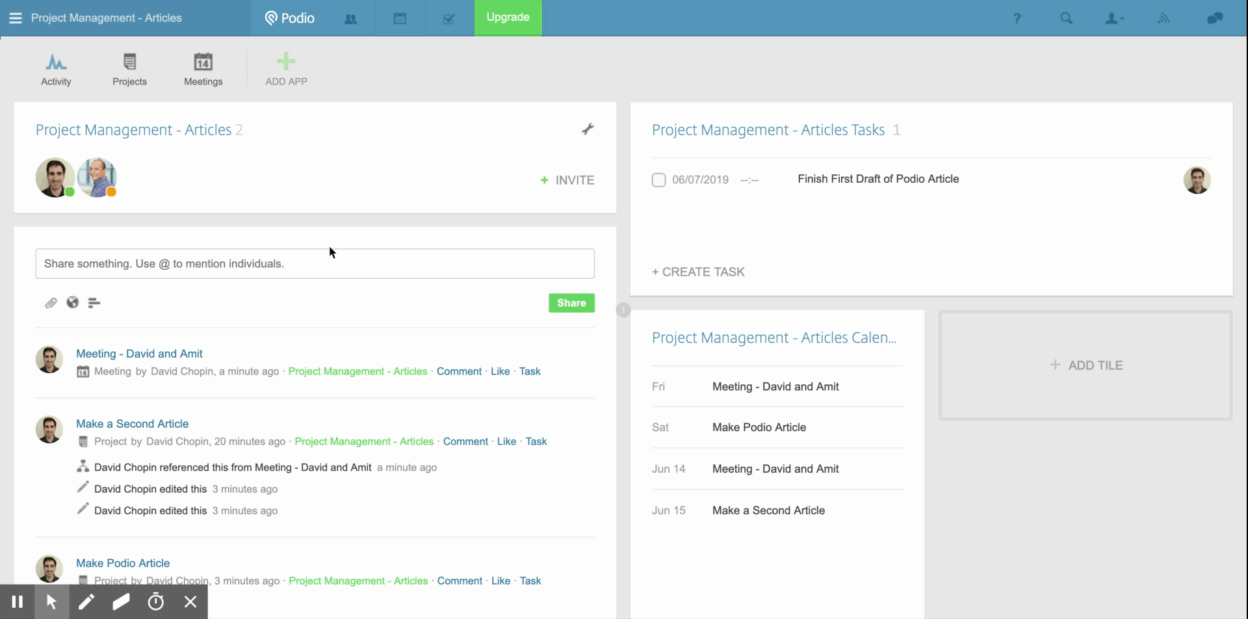In an ever-increasingly connected world, many businesses have a similar problem. They must perfect the art of organizing the many facets of their operations. Failure to structure a business results in poor communication, low motivation, and minimal productivity. Most seasoned professionals would agree that disorganization quickly translates to business failure. Podio aims to relieve this issue.
While many tools have been released to cure business disorganization, Podio takes a unique approach. Podio organizes any aspect of business operations, from team communication to project management and even scrum-like software development. They do this through the use of apps, which can be custom built or downloaded via their app market. This approach ensures that the tool is flexible enough to organize any of your business’s needs. This article looks to give you a thorough understanding of Podio, even if you’ve never launched the app before.
What is Podio?
Podio is a cloud collaboration software that aims to structure most aspects of your business. This alone doesn’t make Podio very unique. But how Podio does collaboration is what really sets them apart. The software tries to be as malleable as possible to ensure they are the right fit for any business.
An organization is broken down into three tiers:.
- Workspaces.
- Apps.
- Items.
Understanding what each of these are and how they work is crucial to getting a good grasp of how Podio can help your business. We’re going to dive into what each of these does and how each relates to one another. By the end, you should have a good enough understanding of Podio to begin implementing it into your business.

Workspaces
Workspaces are where all the collaboration happens in Podio. These workspaces bring together a group of people and provide them with apps that are relevant to their group. Every workspace has an activity stream that lets all members see what exactly is going on in their group.
Let’s say you want to create a workspace that helps organize project management for a content creating team, i.e. organizing the article writing process. Your organization can create a project management workspace that has a number of apps that help coordinate your content-creating efforts. Take a look at a high level demo of a workspace that manages an article-writing team.

Apps
Apps let us create items that help us see what is going on in our workspace. These apps are built from a number of elements, such as text boxes, drop down items, images, progress bars, locations, and more. Users can create any sort of custom app to match what they want to organize. Additionally, Podio provides an app store so that users can make use of pre-made applications. This sharing of applications ensures managers can create a workspace that fits their business environment in a matter of minutes.
In our article project management workspace, we have three apps: Projects, Meetings, and Activity. “Projects” manage each of the individual articles that our team is currently working on. “Meetings” is a calendar that tracks each meeting happening within our team. “Activity” gives us a high-level overview of any major changes that have happened in the other two apps. Activity apps are seen in nearly all Podio workspaces. Take a look at how I can quickly add new articles to my Projects app.

Items
Items are the product of applications. Applications are created by users to generate a list of items. An item can be anything. For example, a project management app will produce projects as items. An app that coordinates articles being created by a blog will produce articles as items. Items are the reason you are using Podio apps in the first place and knowing how to structure them can bring great value to your Podio experience.
In our article project management app, the articles themselves are our items. Similarly, meetings are our items in our Meetings app. Items can represent anything in your business. For example, let’s say I want to track potential companies to write about. With Podio, I could build an app that lets us create items that represent whole companies. Let’s see how I would go about doing that.

The App Market
Podio leverages the power of their apps through their App Market. Instead of having to create an app for processes seen in most businesses, Podio’s App Market gives users access to tons of pre-made apps.
Let’s take a look at just how easy it is to add apps to your Podio workspace through the App Market.

How Much Does Podio Cost?
Podio is a collaboration tool that has a pricing tier for any size business. Their tiers are “Free,” “Basic,” “Plus,” and “Pemium.” Let’s take a look at what each one offers.
Free
Podio’s free plan is, of course, their most limited. But if your team is small enough it might not even make sense to need anything above the free plan. For moderately sized teams though, the free plan just won’t be an option.
Podio is free to use for up to five employees, but the features available to your team will be pretty limited. Free users are only allowed up to 500 items for their organization. 500 may sound like a lot, but it really isn’t when you consider how many workspaces an organization could have. Podio free users also miss out on a whole slew of features that we’ll cover in a bit.
Features:.
- Task management.
- Apps and workspaces.
Cons:.
- Limited to 5 users.
- Missing most of Podio’s better features.
Price:.
- Free (of course).
Basic
Podio’s basic plan offers everything the free plan offers, but with some nice added touches. Perhaps the most notable improvement is the removal of item restrictions. While you can only create 500 items in Podio’s free plan, the basic plan allows for unlimited items. This is a must for teams that are using Podio for a number of their business operations.
The basic plan also adds the user management feature, which allows you to:.
- View all members in your organization, as well as when they were last logged in.
- Designate additional admins for your organization.
- Remove members and guests from your organization.
- View the workspaces that your members are a part of, and their roles within them.
The basic plan also allows for an unlimited number of external users to view your workspaces. Podio uses domain names to tell an organization’s employees apart from external users. After getting your domain set up with Podio, you’ll be able to share your work with as many external users as you like.
Features:.
- All features in pro plan.
- Unlimited items.
- User management.
- Unlimited external users.
Cons:.
- Still missing some advanced Podio features.
Price:.
- $7.20/employee per month (billed annually).
Plus
The plus plan expands on the features offered in the basic plan quite a bit. Plus adds a new user role, the light user role, to the user management feature. A light user has a few less privileges than a regular or admin user. It is there just in case you’re afraid some team members may screw up your workspace.
The plus plan also introduces workflow automation. I could dive into how that works, but you’d probably be better off hearing it from the horse’s mouth.
The plus plan allows for the addition of read-only access. As the name implies, read-only makes it so that apps can only be edited by team members with admin privileges. This concept is common in many business applications.
Features:.
- More user management.
- Automated workflows.
Cons:.
- Missing premium Podio features.
Price:.
- $11.20/employee per month (billed annually).
Premium
Premium is Podio’s highest-tier pricing plan. It gives you all of Podio’s great features, including some that the plus plan doesn’t offer. The only downside is that premium costs nearly twice as much as a plus subscription. Premium offers visual reports, contact sync, interactive sales dashboards, and advanced workflow orchestration – all features that the plus plan doesn’t offer. Most of these features are actually free integrations that you would otherwise have to pay for individually.
The visual reports that the premium plan offers are pretty great. All Podio plans have access to basic reports, but these don’t do a very good job of giving the data any meaning. The reports simply aggregate data in a way where you can see it all, nothing more. Visual reports give this data some more context by presenting it in either tables, bar charts, or line graphs. This feature doesn’t necessarily add any additional functionality, but it should definitely make your Podio experience better.
Contact sync allows you to integrate your organization with PieSync. Integrating with PieSync lets you transfer all of your contacts from other apps (like Google, Office 365, and Salesforce) over to Podio. This can be especially useful for large organizations with hundreds or even thousands of contacts.
Upgrading to premium also lets you create an interactive sales dashboard by integrating with Plecto. Plecto helps you visualize your data through things like speedometers, graphs, and conditional colors. This is just another way to give context to your organization’s data.
The last additional feature premium offers is advanced workflow orchestration. Advanced workflow orchestration is done through GlobiFlow. Integrating GlobiFlow lets users trigger events on certain dates or workspace changes and can save your organization a lot of time.
Features:.
- Visual reports.
- Free integrations with third party apps.
Cons:.
- Costliest plan.
Price:.
- $19.20/employee per month (billed annually).
Recap
So, what is Podio? Podio is one of the most trusted cloud collaboration tools available. Its flexibility lets users create their own tools or download as many as they want from an App Market. Podio’s flexibility and great features come together to make a superb collaboration experience for you and your business.
I hope you enjoyed and learned a lot from this read. Feel free to reach out to us with any cloud collaboration questions!

